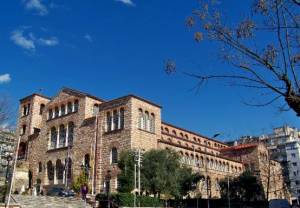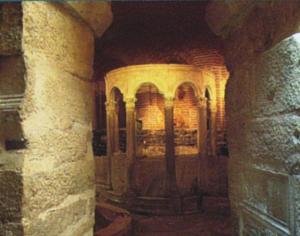
Church of St Demetrius
26th of October is a big day for the city of Thessaloniki. It is the nameday of the city’s patron saint, Saint Demetrius. He was born in Thessaloniki in 270 AD and was executed also here in 305 AD after being tortured on the crypt below the church. After the growth of his veneration as saint, the city of Thessaloniki suffered repeated attacks and sieges from the Slavic people who moved into the Balkans, and Demetrius was credited with many miraculous interventions to defend the city
The Church of Saint Demetrius, or Hagios Demetrios, is the main sanctuary dedicated to Saint Demetrius, dating from a time when Thessaloniki was the second largest city of the Byzantine Empire. It is part of the site Palaeochristian and Byzantine Monuments of Thessaloniki on the list of World Heritage Sites by UNESCO since 1988.
The first church on the spot was constructed in the early 4th century AD, replacing a Roman bath. The church was eventually reconstructed as a five-aisled basilica in 629–634. This was the surviving form of the church much as it is today.
The basilica is famous for six extant mosaic panels that survived through the difficult times the church has passed over the years, depicting St. Demetrius with officials responsible for the restoration and with children. Other magnificent mosaics, recorded as covering the church interior, were lost either during the four centuries when it functioned as a mosque (1493–1912) or in the Great Thessaloniki Fire of 1917 that destroyed much of the city. It also destroyed the roof and upper walls of the church. Following the Great Fire of 1917, it took decades to restore the church. Archeological excavations conducted in the 1930s and 1940s uncovered the ruins of a Roman bath, where St. Demetrius was said to have been held prisoner and executed. A Roman well was also discovered. Scholars believe this is where soldiers dropped the body of St. Demetrius after his execution. After restoration, the church was reconsecrated in 1949.
Underneath the Church of St Demetrios is the cypt, the place where St Demetrios, Thessaloniki’s patron saint, was martyred.

Crypt of St Demetrius
As the level of the ground gradually rose over the centuries, this area acquired the form of a crypt. According both to tradition and to archaeological findings, it was an old bathhouse, in which Demetrios was imprisoned and eventually martyred in ad 303. In the 5th century, when the first Church of St Demetrios was built, the site of his martyrdom was incorporated into the church and the fountain was converted into a source of holy water. In the years that followed, the fountain acquired basins, from which the faithful could collect myron, the sweet-smelling oil produced by the saint’s relics. The crypt filled up with earth during the period of Ottoman rule and was not rediscovered until after the fire of 1917. It has been restored by the Archaeological Service and was converted into an exhibition space in 1988.
Source
 This is the #1 destination for anyone who is stuck in the city or just returned from vacations and want to feel like they did not. If you are in town for a few days only this is a must visit as it combines the historical visit with a relaxed drink or dinner.
This is the #1 destination for anyone who is stuck in the city or just returned from vacations and want to feel like they did not. If you are in town for a few days only this is a must visit as it combines the historical visit with a relaxed drink or dinner.


